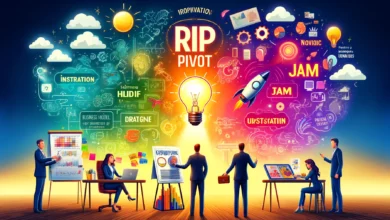Master Lafley & Martin’s 5-Step Strategy Model

Charting Your Course to Success
Ever feel like your business or even your personal life lacks direction?
That’s where strategy comes in – it’s like having a roadmap to achieve your goals. Think of it as the compass that guides you through ever-changing markets, fierce competition, and unforeseen challenges.
Two business giants, A.G. Lafley and Roger Martin, who once steered the massive ship of Procter & Gamble, have laid out a five-step strategy model in their book “Playing to Win.” It’s like a treasure map with five clear checkpoints to help you build a winning game plan.
This model focuses on two key decisions: where you’ll play (think target market and competition) and how you’ll win (your unique advantage and value proposition).
But it doesn’t stop there! The model also guides you on building the skills and systems you need to make your plan a reality.
Sure, every great journey has its hurdles, and so does implementing this model. It might seem complex at first, but the benefits are undeniable. Think clarity, focus, and a sharp edge over your competitors.
So, are you ready to ditch the aimless wandering and set sail for success? Buckle up, because we’re about to dive deep into each step of Lafley and Martin’s five-step strategy model!
Step 1: Dream Big with Your Winning Aspiration
Forget boring mission statements – this step is about unleashing your inner visionary!
Your winning aspiration isn’t just what you do, it’s the impact you aim to make. It’s the North Star that guides your every decision and keeps you fired up even when things get tough.
Think of Apple, who didn’t just want to sell computers, they aspired to revolutionize technology. Or Netflix, who weren’t content with video rentals, they aimed to redefine entertainment. Even Starbucks didn’t settle for brewing coffee, they dreamt of inspiring human connection.
So, how do you craft your own winning aspiration?
Here’s the recipe:
Inspire yourself:
Make it something that gets you truly excited, something you’d love to wake up to every day.
Aim high:
Don’t be afraid to dream big! A mediocre aspiration won’t ignite the fire needed for long-term success.
Keep it real:
Ground your dreams in practicality. Make sure your aspiration is achievable within your resources and capabilities.
Align with your values:
What kind of impact do you want to have? What legacy do you want to leave? Make sure your aspiration reflects your core values and beliefs.
Now, let’s get practical! Brainstorming sessions with your team can spark amazing ideas. Use tools like SWOT analysis to identify your strengths, weaknesses, opportunities, and threats, and see how they fit into your grand vision.
Talk to your stakeholders, customers, and employees – understanding their needs and aspirations can add invaluable perspective.
Revisit your winning aspiration regularly to ensure it stays relevant and keeps your flame burning bright. By putting your heart and soul into this step, you’ll set the stage for a truly phenomenal journey.
Step 2: Planting Your Flag in the Right Territory
Imagine starting a business without choosing a location!
That’s the essence of this step: pinpointing where you’ll play. It’s not just about picking a target market, it’s about understanding the landscape.
Who are your neighbors (competitors)?
What are the local rules (industry dynamics)?
And most importantly, who are the citizens you want to serve (customers)?
Think of e-commerce giant Amazon. They didn’t try to conquer every corner of the internet; they built their empire by playing the “dominant online marketplace” game.
Tesla didn’t aim to compete with every carmaker; they carved a niche as the “electric vehicle pioneer.”
And IKEA? They knew the “affordable furniture giant” territory was where they’d flourish.
So, how do you figure out your ideal playing field?
Tools like Porter’s five forces can reveal your industry’s competitive landscape.
PESTEL analysis helps you map out those pesky Political, Economic, Social, Technological, Environmental, and Legal factors that might impact your game.
Once you know the lay of the land, it’s time to segment your potential customers – think of it as dividing the territory into manageable neighborhoods. Then, position yourself like a commanding general, claiming your unique spot in the minds of your target audience.
Tools like the attractiveness matrix, BCG matrix, and Ansoff matrix can help you assess the potential and risks of different playing fields before you plant your flag.
Remember, choosing your “where to play” is a crucial decision. It shapes everything from your marketing strategies to your product development. Don’t rush into this – take the time to research, analyze, and strategize. kingdom of business.
Step 3: Unleashing Your Winning Weapon – How You’ll Rule the Game
Remember that epic movie scene where the hero unveils their secret weapon? This step is like that moment! It’s all about discovering how you’ll win – your unique superpower that sets you apart in the competitive arena.
Think of Google, their weapon is their superior search technology, the Excalibur that slays every “what, where, why” query.
Nike takes down the competition with their relentless performance innovation, building faster, cooler shoes every season.
And Zara? They’re the ninja of the fashion world, conquering the market with their fast fashion leadership, churning out trendy threads at lightning speed.
So, how do you find your own hidden arsenal?
Tools like value chain analysis help you dissect your operations, identifying where you shine and where you need to sharpen your blade.
The VRIO framework asks four key questions: Is your advantage valuable? Rare? Inimitable? Organized to be exploited? Answer “yes” to all four, and you’ve got yourself a winning weapon!
But wait, there are different strategies for wielding your weapon! Generic strategies like cost leadership or differentiation can guide your overall approach.
Want to create a whole new battlefield?
Consider the blue ocean strategy, exploring untapped markets where competition is nonexistent. Or, if you’re just starting out, the lean startup method teaches you to test and iterate your offering quickly, ensuring you don’t miss your target.
Choosing your “how to win” is like picking the right tool for the job. Analyze your strengths, research your competitors, and experiment with different strategies.
A well-honed weapon isn’t enough; you need the skill and strategy to wield it effectively. By mastering your unique advantage, you’ll transform from a competitor into a formidable force, dominating the battlefield with every move.
Step 4: Gearing Up for Victory – Building Your Winning Arsenal
Think of your winning strategy as a grand plan, but without the right tools, it’s just words on paper.
This step is about gathering the necessary capabilities – the skills, resources, and processes that transform your grand plan into a reality.
Imagine Disney without its legendary creativity and storytelling – their magic would evaporate!
McDonald’s wouldn’t be synonymous with fast food without their operational efficiency – those burgers wouldn’t flip themselves!
And Spotify’s personalized music wouldn’t resonate without their cutting-edge music streaming technology.
So, how do you identify the missing tools in your toolbox?
Tools like a capability map lay out your current skills and resources, highlighting the gaps between your dreams and your reality. A capability gap analysis digs deeper, pinpointing the specific areas you need to strengthen. And the capability maturity model assesses your progress, telling you if you’re a fledgling apprentice or a seasoned master in each area.
But acquiring new skills isn’t just about textbooks and training camps.
The learning curve can be steep, so consider the build-borrow-buy framework.
Can you build the capability in-house with your own team?
Borrowing expertise through partnerships or collaborations might be faster. Or, if time is of the essence, outsourcing specific tasks could be the key.
Very important, building capabilities is an ongoing process. Don’t expect to turn into a superhero overnight! Use a decision matrix to analyze risks and rewards of each option, and prioritize your investments wisely. Track your progress, adapt your strategy, and keep learning. Always try to build a formidable arsenal that allows you to execute your plan with precision and power, transforming your dreams into tangible victories.
Step 5: Building the Engine Room – Management Systems to Fuel Your Journey
So, you’ve crafted your winning plan, gathered your tools, and are ready to charge towards your goals. But hold on, adventurer!
You need a strong engine room to keep your ship sailing smoothly through choppy waters.
This step is all about management systems – the structures, policies, and measures that ensure your strategy stays on track and propels you forward.
Think of Southwest Airlines with its culture of employee empowerment. Their decentralized decision-making keeps their engines humming, allowing employees to adapt quickly and delight passengers.
Netflix thrives on data-driven decision making. They continuously analyze user behavior, fine-tuning their algorithms to serve up entertainment that keeps viewers glued to their screens.
And Toyota? Their secret sauce is continuous improvement. They never stop tweaking and optimizing, ensuring their cars run smoother and more efficiently year after year.
So, how do you build your own engine room?
Tools like the balanced scorecard offer a comprehensive dashboard, tracking not just financial metrics but also customer satisfaction, internal processes, and learning and growth.
The OKR framework sets clear objectives and key results, giving your team a roadmap to navigate towards success. And for agility in a fast-paced world, consider the agile methodology, allowing you to adapt and iterate quickly based on real-time feedback.
But remember, even the best engine needs maintenance.
Use the PDCA cycle (Plan-Do-Check-Act) to continuously monitor your systems, identify areas for improvement, and implement tweaks to keep your strategy humming.
Regularly gather feedback from all levels of your organization, and nurture an innovation funnel that encourages new ideas and experimentation.
Building strong management systems takes time and effort, but the rewards are immeasurable.
By aligning your structures, policies, and measures with your strategy, you create a well-oiled machine that drives you towards your goals.
Remember, even the most daring adventurer needs a reliable engine room – with a well-designed system powering your journey, you’ll conquer any obstacle and reach your destination with confidence and triumph.
Charting Your Course to Success: The Final Voyage
So, there you have it, adventurer!
Lafley and Martin’s five-step strategy model has equipped you with a treasure map brimming with tools and insights to navigate the complex seas of business.
This model isn’t just a one-time adventure; it’s a compass you can turn to again and again to refine your course and stay ahead of the competition.
Let’s raise the Jolly Roger of clarity, focus, and competitive advantage.
This model cuts through the fog of uncertainty, helping you define your winning goal (aspiration), choose the right battlefield (where to play), wield your unique weapon (how to win), build your arsenal (capabilities), and fuel your journey with well-oiled systems (management).
However, even the smoothest seas can have choppy patches. Implementing this model requires commitment and an iterative approach. Don’t expect a perfect plan overnight.
Be prepared to adjust your sails, adapt your strategy based on feedback, and continuously learn and improve. Remember, every great voyage is a series of calculated risks, adjustments, and triumphs.
So, are you ready to set sail and claim your own business horizon?
Use this model to chart your course, gather your crew, and embark on your winning journey! But don’t forget to pack your trusty toolkit – Lafley and Martin’s book, “Playing to Win,” is a treasure trove of further insights. Online tools and articles can also offer valuable guidance and inspiration.
The only limit to your success is your willingness to chart your course and navigate the winds of change.
With Lafley and Martin’s map as your guide, you have the power to conquer any obstacle and claim your rightful place as a captain of your own destiny.
Bon voyage, adventurer!





